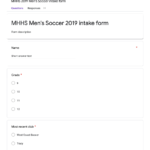One of the challenges we have as coaches is responding to the players’ evolving needs as they proceed on their athletic journey. Through observation, we continually evaluate the players and team against objective and subjective measurements. We must recognize the players’ role in their journey and the importance of their self-reflection process. Coaching is ultimately a relationship between the coach and player. Understanding the player’s self-image and needs allows the coach to design and implement individual development programs (IDPs) more successfully.
As part of my process, I regularly gather self-assessment data from my players. Typically, this will happen at the beginning of a seasonal cycle – for example, after tryouts or returning from a mid-season break. At the end of this article, I provide two examples of self-assessment forms: the intake form that I’ve used with high school teams and a survey form that I’ve used with younger club players. In both cases, I am using web sites to deliver online forms. For many coaches, a simple written form is an easier way to gather player self-assessments.
Our friends at SoccerPulse have an excellent app for self-reported player wellness and periodization. I strongly recommend this app for coaches working with older teams. I’ve been using SoccerPulse with our high school athletes as part of my United Soccer Coaches Master Coach project.
In my current high school program (JV Boys), I have two pools of players: returning players with whom I am familiar and new players (freshmen) of whom I have no coaching experience. I need to know some things about how the players view their role on the team within the game – their self-identified position, club backgrounds and level, their view of themselves (strengths and areas to work on), any injuries that they are carrying, their goals, and other things that they think I should know about them. I try to use open-ended questions and use their answers to begin the conversations to build relationships.
With younger club players, I’ve used some specific questions in addition to providing space for open-ended questions. I use a Likert-scale (1 to 5 stars, strongly disagree to strongly agree) to give some structure to their responses. I also use top-3 strengths and areas to work on. I am less interested in their positional preferences as I expose them to different roles as part of the development process. For most players in these age groups, the parents are involved in responding to the self-assessment – clicking on links, guiding the player to answer questions, and submitting the responses.
An essential question for every player regardless of age group is their “why” – what it is about soccer, the team, and the program that motivates them. As coaches, we often view the players from the standpoint of their physical performance and soccer abilities. We assume, imprinting our adult mindset onto the players, that they share our motivations – the acts of physical participation, the development of skills, and success within the parameters of the game.
On the question of “why,” the responses that I receive typically fall into one of three somewhat overlapping categories. Some players describe extrinsic motivators – for example, the elite high school players focused on college scholarships, for younger players winning tournament trophies and – in a few cases – getting parent rewards for scoring goals. The majority of responses that I receive revolve around an expression of “fun” – the player’s enjoyment in participating in the game. For some, the experience of socialization – making friends, belonging to a team, being valued by peers – is a primary motivator.
Understanding each player’s “why” helps to provide a foundation for the coaching relationship. Early in my coaching career, I sometimes fell into the trap of viewing each player exclusively through the window of the 2-3x/week 90-minute practice session. In some cases, I became frustrated that my attempts to respond to player issues within those windows were unsuccessful. The use of intake forms and self-assessment surveys helps provide me with a deeper understanding of the world that the player lives within, of which the 90-minute practice sessions are a small part. In a few cases, the self-assessment has resulted in more in-depth conversations – with the player or with both parent and player – about how to work as a team moving forward.
It is important to note that players evolve over time. Many coaches – particularly parent or grassroots coaches – follow teams through age groups. The player that we see at age 12 is different from the one at ages 14 or 16. The physical changes are most apparent, but the players’ psychological attributes – priorities, motivations, self-view – are continually evolving. The player’s personal situation will also change over time – family and social relationships, academics, and life goals. It is crucial that we don’t lock in our view of the players.
In summary, we should continually check in with our players. Intake forms and self-assessment surveys are useful tools to begin relationships or add to the relationships that we currently have.
High school intake form
Our high school has guidelines regarding the methods that we use to interact with players. This survey uses Google Forms through the high school’s web site. Google Forms produces some basic data entry information and can be exported as a spreadsheet for analysis. I have used other survey tools (LimeSurvey) in previous jobs to gather player feedback.
Click the images to expand.
Club self-assessment survey
I’ve used this survey with players in the U9-U12 age groups. I use the WPForms plug-in as part of the 205 Sports web site. WPForms also produces a spreadsheet for analysis.
Click the images to expand.

